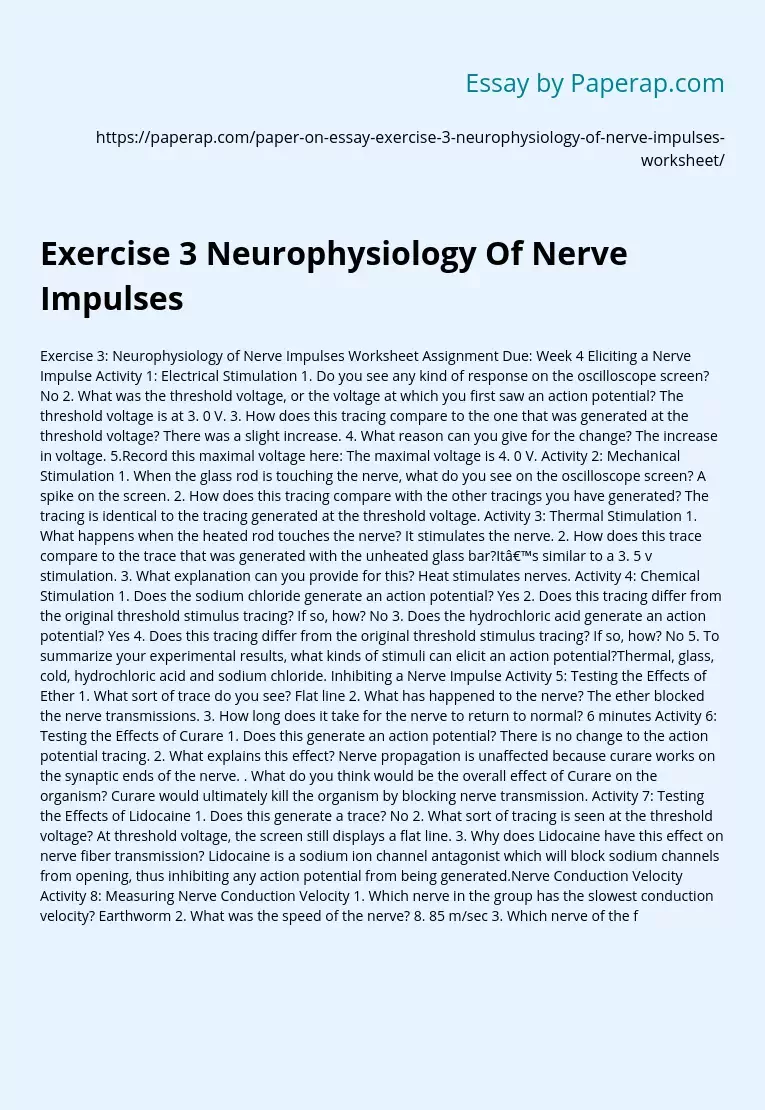Exercise 3 Neurophysiology Of Nerve Impulses
Exercise 3: Neurophysiology of Nerve Impulses Worksheet Assignment Due: Week 4 Eliciting a Nerve Impulse Activity 1: Electrical Stimulation 1. Do you see any kind of response on the oscilloscope screen? No 2. What was the threshold voltage, or the voltage at which you first saw an action potential? The threshold voltage is at 3. 0 V. 3. How does this tracing compare to the one that was generated at the threshold voltage? There was a slight increase. 4. What reason can you give for the change? The increase in voltage.
5.Record this maximal voltage here: The maximal voltage is 4. 0 V. Activity 2: Mechanical Stimulation 1. When the glass rod is touching the nerve, what do you see on the oscilloscope screen? A spike on the screen. 2. How does this tracing compare with the other tracings you have generated? The tracing is identical to the tracing generated at the threshold voltage. Activity 3: Thermal Stimulation 1. What happens when the heated rod touches the nerve? It stimulates the nerve. 2. How does this trace compare to the trace that was generated with the unheated glass bar?It’s similar to a 3.
5 v stimulation. 3. What explanation can you provide for this? Heat stimulates nerves. Activity 4: Chemical Stimulation 1. Does the sodium chloride generate an action potential? Yes 2. Does this tracing differ from the original threshold stimulus tracing? If so, how? No 3. Does the hydrochloric acid generate an action potential? Yes 4. Does this tracing differ from the original threshold stimulus tracing? If so, how? No 5. To summarize your experimental results, what kinds of stimuli can elicit an action potential?Thermal, glass, cold, hydrochloric acid and sodium chloride.
Inhibiting a Nerve Impulse Activity 5: Testing the Effects of Ether 1. What sort of trace do you see? Flat line 2. What has happened to the nerve? The ether blocked the nerve transmissions. 3. How long does it take for the nerve to return to normal? 6 minutes Activity 6: Testing the Effects of Curare 1. Does this generate an action potential? There is no change to the action potential tracing. 2. What explains this effect? Nerve propagation is unaffected because curare works on the synaptic ends of the nerve. . What do you think would be the overall effect of Curare on the organism? Curare would ultimately kill the organism by blocking nerve transmission. Activity 7: Testing the Effects of Lidocaine 1. Does this generate a trace? No 2. What sort of tracing is seen at the threshold voltage? At threshold voltage, the screen still displays a flat line. 3. Why does Lidocaine have this effect on nerve fiber transmission? Lidocaine is a sodium ion channel antagonist which will block sodium channels from opening, thus inhibiting any action potential from being generated.Nerve Conduction Velocity Activity 8: Measuring Nerve Conduction Velocity 1. Which nerve in the group has the slowest conduction velocity? Earthworm 2. What was the speed of the nerve? 8. 85 m/sec 3. Which nerve of the four has the fastest conduction velocity? Rat Nerve 2 4. What was the speed of the nerve? 46. 74 m/sec 5. What is the relationship between nerve size and conduction velocity? What are the physiological reasons for this relationship? The larger the nerve, the faster the conduction velocity. Conduction velocity is faster if the nerve is myelinated than if it not. . Based on the results, what is your conclusion regarding the effects of myelination on conduction velocity? What are the physiological reasons for your conclusion? In myelinated nerves, conduction velocity is faster as the action potential jumps from node of Ranvier (internode) to node of Ranvier and does not travel along the cell membrane. 7. What are the evolutionary advantages achieved by the myelination of neurons? Attack and escape. Myelinated neurons allow faster reflexes increasing chance of survival, which allows you to pass your genes on to your offspring.
Exercise 3 Neurophysiology Of Nerve Impulses. (2019, Dec 05). Retrieved from https://paperap.com/paper-on-essay-exercise-3-neurophysiology-of-nerve-impulses-worksheet/

